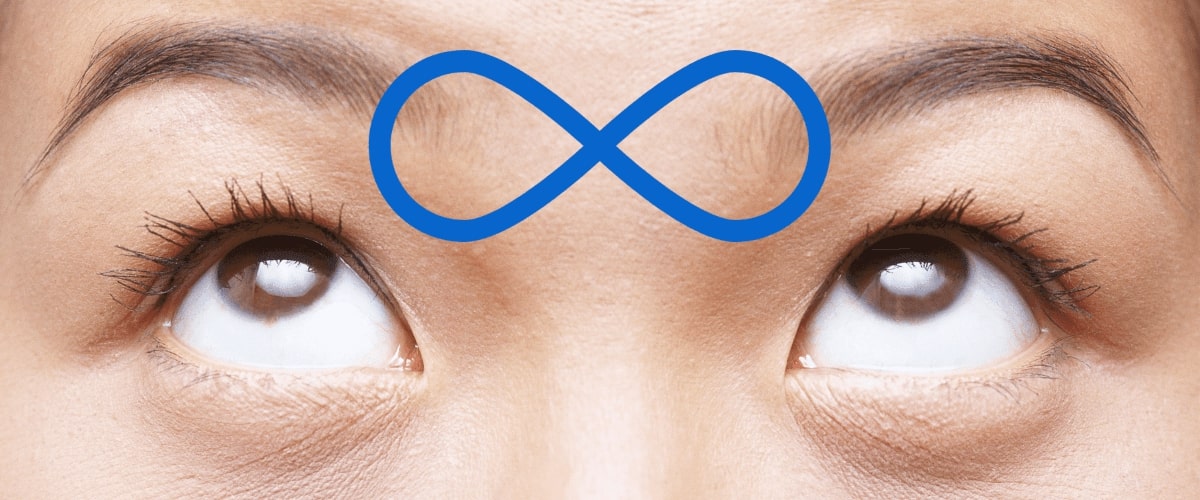6 Great Eye Exercises to Beat Eye Strain
That’s right – eye exercises! They’re a great way of strengthening the muscles in your eyes, improving your focusing system, and developing your visual pathway (the brain’s vision center).
There are many different exercises that you can do for your eyes that can help with a variety of conditions and symptoms – we’ll be breaking some down below!
First off – do eye exercises really work?
While eye exercises are not proven to improve vision (i.e. they won’t replace your need for glasses or contact lenses), they can be very helpful for certain eye conditions and relaxing your eyes.
As well as reducing symptoms such as eye strain, headaches and blurred vision, eye exercises may be helpful for many conditions including:
- Convergence insufficiencyWhen your eyes struggle to work together when looking at nearby objects.
- Depth perception issuesStruggling to judge how far away objects are or see in 3D.
- StrabismusCrossed eyes or an eye turn.
- Following surgeryEye exercises can help to improve muscle control.
That said – eye exercises are not effective for some conditions, including:
- MyopiaWhen distance vision is blurry, but near vision is clear. Also known as near-sightedness.
- HyperopiaWhen near vision is blurry, but distance vision is clear. Also known as farsightedness.
- AstigmatismWhen the front of the eye is not perfectly sphere, causing blurred vision up close and far away.
- PresbyopiaWhen nearby objects gradually become blurrier with age.
- Ocular health conditionsThese include cataracts, glaucoma, and age-related macular degeneration (AMD) among others.
Many studies have shown the great effectiveness of eye exercises for people with binocular vision (how the eyes work together) issues and following surgical procedures.
Why not make a habit of them?
6 eye exercises to try & their potential benefits
1. 20-20-20 rule
Every 20 minutes, focus on something 20 feet away for 20 seconds. It is best to do this exercise during long periods of near work (i.e. computer work or reading).
The magic of this exercise is that it helps your eyes relax from focusing so hard on your up-close task. While doing near work, people tend to blink less often – so, doing this exercise gives your eyes the chance to rehydrate while looking in the distance. The 20-20-20 rule is best at reducing digital eye strain and headaches.
Some studies have also suggested that taking breaks from near work, such as performing the 20-20-20 exercise, can help reduce progression of myopia (short-sightedness) in children.
2. Blink break
Take a break from focusing on near work or TV and put effort into blinking at a normal rate. As mentioned earlier, we tend to blink less when we are focused on TV or computer screens. This can cause eye strain, headaches, and dry eyes. It is best to do this exercise when you have spent a lot of time focusing on screens or if you are beginning to get dry eyes or a headache.
3. Figure 8
Focus on an area roughly 8 feet away and move your eyes in the shape of a figure 8 for 30 seconds. After 30 seconds, repeat this in the other direction.
This eye exercise helps relieve digital eye strain. You should do this exercise when you start feeling dry eyes, headaches, or eye strain.
4. Changing focus (near and far)
Hold your pointer finger a few inches from your eye. While focusing on your finger, slowly move it away from your face. Then, switch your focus between your finger and an object in the distance. Finally, bring your finger closer to your eye again and switch your focus again.
Repeating this exercise a few times will improve symptoms of digital eye strain. It is also best to do this exercise while sitting down.
5. Brock string
To do this exercise, hold one end of the Brock string (or a long string with colored beads) up to your nose and tie the other end to a fixed object (such as a doorknob).
When you look at the bead closest to you. You should see one image of the bead, with two shorter strings leading up to it and two longer strings leading away from it. The strings will form an “X” shape around the bead. If you see two images of the bead (double vision), move the bead further away until it becomes single again. As you get better at this exercise, gradually move the bead closer towards you.
Once you can comfortably see the “X” shape, switch your focus between colored beads while making sure that you continue to see the strings forming an “X” shape.
The Brock string eye exercise improves convergence (when the eyes come together to focus on near objects) and to reduce suppression (when the brain ignores the visual signals coming from one eye). It is recommended to do this exercise once or twice a day, 5 or 6 days a week. If you are doing this exercise as part of vision therapy, do it as frequently as your optometrist or ophthalmologist suggests.
6. Pencil push-ups
Hold a pencil (or an object with a pointed tip) in the middle of your vision at approximately arm’s length, and slowly move it closer to your nose. Try to keep the image of the pencil single. As soon as the pencil becomes doubled, slowly bring it further away until it is clear again. Repeat this process for at least a minute (roughly 20 cycles). After doing pencil push-ups, you can relax your eyes again by focusing in the distance for a minute.
This eye exercise is usually involved in vision therapy and is helpful for convergence insufficiency. If you are doing this as a part of vision therapy, you should do the exercise as often as your optometrist or ophthalmologist recommends. If you do pencil push-ups at home, you can do the exercise 2-3 times daily.
What is vision therapy?
Vision therapy is usually performed by an optometrist, ophthalmologist, or orthoptist. After an eye examination, if you have any conditions that may benefit from vision therapy, your optometrist may refer you to someone who will recommend eye exercises.
Vision therapy helps develop and improve visual abilities, visual processing and efficiency. This can include helping with conditions such as convergence insufficiency, strabismus, or accommodative (focusing system) issues among others.
If your vision is blurry, doubled, or if you experience headaches or eye strain then you should see an optometrist or ophthalmologist. It is also important to have regular comprehensive eye examinations (every 2 years or as recommended) for your sight and health.
While these eye exercises may help to relieve your symptoms, it is important to get a professional opinion if in doubt. Sometimes these symptoms can be caused by refractive errors (meaning you may need glasses or contact lenses) or ocular health conditions.
References
- WebMD – ‘Eye Exercises’
- Medical News Today – ‘Eye exercises: some tips and techniques’
- National Eye Institute – ‘Eye Exercises: How-to, Efficacy, Eye Health, and More’
- Healthline – ‘How Does the 20-20-20 Rule Prevent Eye Strain?’
- Review of Myopia Management – ‘The 20-20-2 Rule’
- Optometrists Network – ‘How Is a Brock String Used?’
- The Vision Therapy Centre – ‘How the Brock String is Used In Vision Therapy’
- Middle East African Journal of Ophthalmology – ‘The Effectiveness of Home-based Pencil Push-up Therapy Versus Office-based Therapy for the Treatment of Symptomatic Convergence Insufficiency in Young Adults’

Written by:
Dr. Jordan Marr













